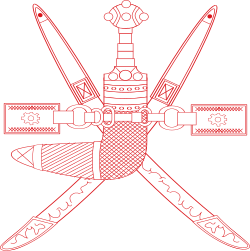Coat of arms of Oman
| National Emblem of Oman | |
|---|---|
 |
|
| Details | |
| Armiger | Sultan of Oman |
| Escutcheon | A khanjar (dagger) in a sheath that is superimposed upon two crossed swords |
The national emblem of Oman (Arabic: شعار سلطنة عمان) is an insignia consisting of a khanjar inside its sheath that is superimposed upon two crossed swords. Adopted in the 18th century as the badge of the Omani royal family, it subsequently became the national emblem of the Sultanate of Oman. The emblem is featured at the canton on the Flag of Oman.
The national emblem was first designed in the mid-18th century, when it was adopted as the royal crest of the Al Said dynasty. Its usage was expanded when it subsequently became the national emblem of the sultanate. This occurred during the reign of either Faisal bin Turki (1888–1913) or Taimur bin Feisal (1913–1932). The emblem was later incorporated onto the canton of the country's national flag in 1970. Moreover, in order to distinguish "directly royal entities" and create a distinct symbol for these organizations, a crown was added to the top of the national emblem. This modified insignia is utilized on the badges of all branches of Sultan's Armed Forces, including the Royal Army, Royal Navy, Royal Air Force, Royal Guard, and Royal Oman Police – among many others.
According to the Omani Ministry of Foreign Affairs, the khanjar – along with the two crossed swords – symbolize the historic weapons utilized by the people of Oman. They are attached together by an embellished [waist belt with its Khanjar at the centre.] The khanjar itself is a national symbol of the sultanate, and is still worn by Omani men as a "ceremonial dagger" for formal occasions.
...
Wikipedia
